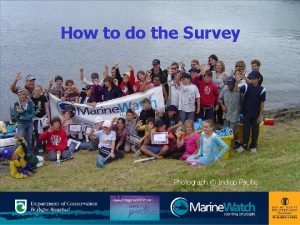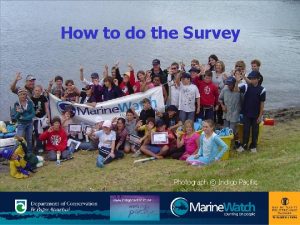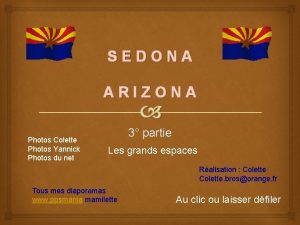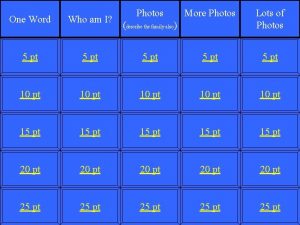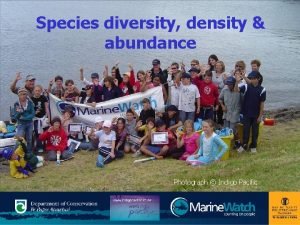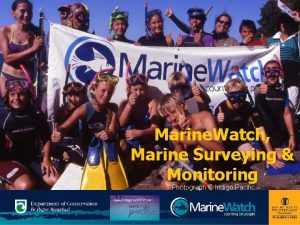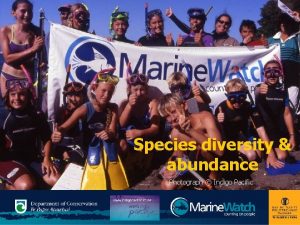How to do the survey Photos Indigo Pacific












- Slides: 12

How to do the survey Photos © Indigo Pacific

Karakia • • • • Ko Rangi Ko Papa Ka Puta ko Rongo Ko Tanemahuta Ko Tāwhirimātea Ko Tangaroa Ko Haumietike Ko Tumatauenga Ko te Rangi ki runga Ko te Papa ki raro Ka Puta te ira tangata Ki te whaiao, ki te ao marama Tīhei mauri ora

• • • What we will be learning about today Snorkelling along a transect line Staying within 1 m of the line Recording the number of marine creatures that we see Estimating species abundance AND Remembering the Marine. Watch Kaupapa: have minimal impact & care for the sea & life that lives there Photograph: Otumoetai Intermediate School conducting the Rocky Reef Snorkel Survey – Department of Conservation

How to do the survey Photograph: Pongakawa Intermediate School conducting the Rocky Reef Snorkel Survey – Department of Conservation • We will be recording animals & plants that found within 2 meters (1 meter either side) of a line that will be laid on a shallow rocky reef. • A line such as this is known by scientists as a transect line. • Coloured floats mark the start and finish of the line. • Swim along the line between the floats recording marine organisms that are pictured on our underwater slates.

How to do the survey • Swim side by side with a buddy. • One way to do the survey is for one of buddy to record on the underwater slate, organisms up to 1 m from the left side of the line while the other buddy looks for organisms up to 1 m from the right side of the line. • Practice estimating how far away 1 m is! Photograph: Pongakawa Intermediate School conducting the Rocky Reef Snorkel Survey – Department of Conservation

How to do the survey • We will need to record how many of each species we see. • We might want to record individual animals or plants as marks on our slate like this l l. • It is likely that for some animals like star fish or octopus we won’t see very many – like maybe only 1 or 2 or maybe 5. Photograph © Indigo Pacific

How to do the survey • But for other animals like oysters or mussels or pupu there might be hundreds or thousands of them! • Count a small area of them and then multiply this number to estimate how many there are. • It is VERY important for the survey that we do this accurately and without exaggeration. • Try estimating how many animals there are in these pictures! Photographs © Indigo Pacific

How to do the survey • • • Where we are surveying sea weed – record the abundance (how many) as a percentage of the total cover. Imagine there is a square 1 m by 1 m. The transect line forms one edge to this square. Decide what percentage of the square is covered by that particular sea weed and write this down with a % sign next to it. What percentage cover of seaweed is there in each of these squares? Photographs © Indigo Pacific

How to do the survey • How many times do we do the survey? • Once we have completed the first snorkel transect, there is space on the slate to conduct a second. • It will be interesting to see whether results differ between the first and second transects. • How will you communicate with your buddy while snorkelling? • Photograph: Otumoetai Intermediate School conducting the Rocky Reef Snorkel Survey – Department of Conservation

What do we record • We’ll need to record some other information such as the time and date, tide and weather conditions • There is space to fill this out at the top of the slate • We might also wish to record unusual sightings. Sometimes unusual animals such as squid or octopus can be seen. • Other times it might be a more bizarre un-ocean like thing such as a bicycle or letterbox that someone has dumped at sea. (One time we even found a television set!) • We might also count the number of rubbish items seen during the survey.

Keeping the Kaupapa • When we are surveying remember the Marine. Watch kaupapa of minimal impact and caring for the sea and the life that lives there. This means not kicking the rocks or seafloor with our fins and not Photograph: Pongakawa Intermediate School disturbing sea weed or conducting the Rocky Reef Snorkel Survey – Department of Conservation any marine animals.

Species identification • Use the species identification slides from your area to practice identifying marine organisms you may see on your survey! Photograph: Octopus www. indigopacific. co. nz
















